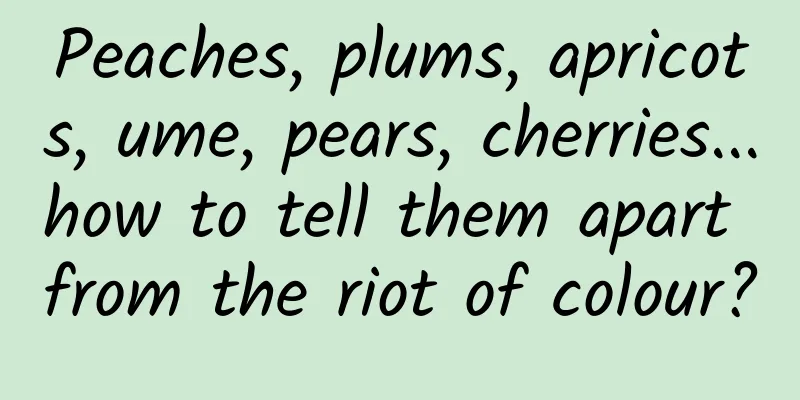Peaches, plums, apricots, ume, pears, cherries...how to tell them apart from the riot of colour?

|
At least half of the beauty of spring is given by flowers. From the end of February, flowers began to bloom one after another from the south to the north of the motherland. From the plum blossoms that "bloom alone in the cold", to the "beautiful as peach and plum" that are as beautiful as beautiful women, to the "pear blossoms fall on Qingming", "apricot blossoms end in spring and Qujiang is idle", to the colorful cherry blossoms and the crabapple blossoms that remain... This succession of beauty makes the whole spring beautiful. However, no matter how many times you have admired flowers, if you invite all the fairies to gather together and let us distinguish them one by one, it is not certain that many people can tell who is who. The flower season has begun. In order to avoid making a fool of yourself, today I will tell you in detail the appearance characteristics of various flower fairies. Tuchong Creative 01 Whether there is a plot or not does not affect the appearance [Protagonist] There is no primary or secondary distinction in the world of flowers. They are called the protagonists only because they are more common in our lives. For these ornamental flowers, we also divide them into two groups: those with stalks and those without stalks. The principle of division is generally described as whether the flowers have stalks or not, and a more vivid description is whether the flowers have pedicles or not. The "stemless" group represented by plum, apricot, and peach There are three big guys in this group - plum blossoms, apricot blossoms and peach blossoms. Their common feature is easy to identify, that is, they have no pedicels and the flowers grow attached to the branches. plum bossom: The unique feature of plum blossoms is that they bloom very early. In the Jiangnan region, they bloom in early January, and in Beijing, they bloom in mid-March. Green-calyx plum, a plum blossom with a melon scent, can be found in both the north and south Apricot and plum, the result of the love between apricot and plum Peach and apricot: The common feature of the wild peach and the wild apricot is that the petals are very thin but dense, and there are no leaves when they bloom. The difference between the two is that the calyx of the wild peach is not reflexed, and the trunk is very greasy, as if it were painted brown-red, while the calyx of the wild apricot is reflexed, and the trunk is rough gray. Peach tree trunk Mountain peach blossom Prunus armeniaca The sepals of the apricot tree are obviously reflexed. The blooming time of apricot blossoms is after that of wild peach and wild apricot. Generally speaking, it is very similar to wild apricot, but the flowers are fuller than those of wild apricot. Apricot blossoms appear fuller Peach blossoms bloom the latest, and there are mainly two types of peach blossoms: plump green peach blossoms and fruit-bearing peach blossoms. The flowers of the peach are the most beautiful in the sessile group, with many petals on the flowers, and the red peach is the star. In addition, some unspeakable things happened between the peach and the mountain peach, so a lot of illegitimate children appeared, and now they have become the main force of spring ornamental flowers. Peach blossoms are thinner than those of pink peach trees, the leaves are long and the flowers are attached to the branches, and it can bear peaches. Another criterion for judgment is that peach trees usually have peach gum. Red Leaf Peach Authentic Peach Blossom This is actually a hybrid of a peach and a mountain peach. White-flowered mountain peach is a very common ornamental garden variety, which is a combination of mountain peach and pink peach. 【Herbal style】 There are also three big names in the pedunculated group - cherry blossoms, crabapples and pear blossoms. Their characteristics are that the flowers have peduncles. The core difference between these three big names lies in the number of pistils: cherry blossoms have only one style, while crabapples and pears have more than one. Cherry blossoms: Cherry blossoms are actually a mixture of many species, and here we are only talking about the universal principle. Each flower has only one green style (with the exception of one species called Puxianxiang), which is obviously different from crabapples. In addition, there is a notch at the top of the cherry blossom petals, which is either deep or shallow, which is a feature that peaches, plums, apricots, apples, and crabapples do not have. In addition, the young leaves of cherry blossoms are folded together, and there are obvious ring-shaped patterns on the bark. Combining these characteristics, it is easy to identify cherry blossoms. According to the blooming time, cherry blossoms are divided into three categories: early, mid and late. The early cherry blossoms are represented by Kanhizakura and Okanzakura, the mid-blooming cherry blossoms are represented by Somei Yoshino, and the late cherry blossoms are represented by Guanshan and Puxianxiang. Cold cherry blossom Somei Yoshino, the representative of the Chinese cherry blossoms and the main variety of Japanese cherry blossoms Japanese late cherry blossoms, Guanshan Begonia: If you look closely, you can easily tell them apart, because most crabapples have 5 styles. There are three major crabapple species: the Western Crabapple (5 styles), the Crabapple Flower (5 styles), and the Weeping Crabapple (4 or 5 styles). The Weeping Crabapple is particularly shy, with drooping flowers and red pedicels; the other two are more like tomboys, standing straight. The Western Crabapple has "pollen flowers and red fruits", while the Crabapple Flower has "white flowers and yellow fruits", which is the main difference between the two. Weeping Begonia Begonia Begonia pear: Pear flowers are also a mixture of species, and the number of stigmas varies. One of the biggest features is that the flowers and leaves grow at the same time, and the stamens and anthers of pear flowers are red, which is the most obvious feature that distinguishes it from other spring ornamental flowers. Pear Blossom In addition to the above representatives, the more common spring ornamental flowers include red leaf plum, or purple leaf plum. Its flowers are relatively thin, the leaves are close to reddish brown, and the young leaves are rolled up like rolls of paper, and the fruiting rate is very high. Purple Leaf Plum 02 A person with a complicated life story and a family background [Supporting Characters] The following flowers do not appear very frequently, but they are still very important ornamental flowers and are generally very beautiful. Beauty plum: The illegitimate child of plum blossoms and purple-leaf plums, it has the fullness of plum blossoms and the density of purple-leaf plum flowers. It is a great ornamental flower plant. Beauty plum Begonia truncatula: It is not usually mistaken for cherry blossoms, because they are too short and are usually shrubs. But it should be mentioned that their fruit is edible, that is, the very sour "sour papaya", not the kind sold in supermarkets. Nowadays, you can often see it in Beijing's parks and roadside green belts. Buds of Malus truncatum Begonia in full bloom Hairy cherry: It is not a hairy cherry, but a relative of the cherry. It has almost no pedicels, the flowers are densely packed, and the fruit is hairy. Cherry tomentosa Prunus mume: We have to mention the elm-leaved plum, which is also a very important main force in the sessile school. The flowers are very similar to apricot plums and peaches, but the leaves are like the leaves of elm trees, hence the name. Prunus armeniaca The many identification methods mentioned above are just following general principles. Nowadays, there are more and more types of gardening, and it is becoming more and more difficult to distinguish them accurately. Specific judgments need to be made based on actual conditions. 03 Regarding the frequently asked question "Can I eat it?" You can’t have both pleasing eyes and delicious food Where there are flowers, there are fruits, and where there are fruits, people ask, “Can I eat it?” Let's talk about cherry blossoms and cherries first. In a broad sense, the flowers of plants in the subgenus Prunus of the Rosaceae family can be called cherry blossoms, of course, including the flowers of three types of cherries (cherries, European sweet cherries, and European sour cherries), but some of these cherries are specially cultivated for flower viewing. In fact, most of the cherry blossoms used for flower viewing produce very bitter fruits that are not edible. As for the crabapple family, the main contributor to crabapple fruit is the crabapple flower. As for the Western crabapple and the weeping crabapple, they are mostly grown for viewing. Their fruits are small and sour, and they are not suitable for the "dining table". Some varieties of fruits will show bright red (Western crabapple) and yellow (crabapple flower), which are also new crabapple varieties cultivated by horticulturists. Of course, this does not mean that crabapples cannot contribute to our fruit baskets - crabapples can be good rootstocks for apples. Tuchong Creative The same is true for other flowers such as peach, plum, apricot, and pear. For plants used for viewing flowers, we should just enjoy the beauty of the colorful flowers. If you want to enjoy juicy, sweet and delicious fruits, you should go to the orchard. However, when the orchard blooms in large areas, the scenery is also beautiful, so you might as well go and see it when you go for an outing. Author: Shi Jun, CEO of Corn Lab Review | Wang Kang Director of Beijing Botanical Garden Science Center Professor-level Senior Engineer This article is produced by the "Science Rumor Refutation Platform" (ID: Science_Facts). Please indicate the source when reprinting. |
<<: Understanding Russian History in One Breath (3)
>>: Learned! It turns out that there are at least 5 ways to die from the new coronavirus...
Recommend
When ancient history meets cutting-edge technology: Helping to decipher Greek inscriptions and achieving a dance between AI and humanity?
*Inscriptions and steles are the embodiment of th...
30 information flow cases to teach you how to improve conversion
January's creative sharing is finally here! A...
Asian Games are coming soon, take care of your knees, save this "white list" of knee joint exercises
Hangzhou Asian Games is about to be held If you l...
BYD's second-generation Yuan PLUS Intelligent Driving Edition: a new benchmark for A-class pure electric SUVs in the era of intelligent driving equality
On March 5, 2025, BYD Dynasty series added anothe...
How much does it cost to make a gardening applet in Guyuan?
How much does it cost to develop the Guyuan Garde...
Volcano Engine live4D volumetric video solution selected for SIGGRAPH Asia 2023, supports interactive experience
Recently, SIGGRAPH Asia 2023 (The 16th ACM SIGGRA...
Typed yet flexible Table View Controller
[[163982]] UITableView is like bread and butter f...
Half of the world's population is concerned about the health effects of the internet and smartphones
In the post-epidemic era, technology's domina...
The entire iPhone 13 series no longer supports China Telecom's 2G/3G network
A few days ago, Apple’s official support website ...
Uncovering the secret of Toutiao’s growth — A/B testing
In 2018, the growth of China's mobile Interne...
How long did it take to travel the eastern section of the Silk Road, which follows the river, in ancient times?
How long did it take for ancient people to travel...
Cartoon | Will you be "genetically modified" if you eat genetically modified food?
Will eating genetically modified food make you &q...
Google debit card exposed! Will the competition among US mobile payment giants escalate?
As early as September 2019, news of Google develo...
WeChat red envelope cover upgrade: individuals can also customize
On November 4, the WeChat red envelope cover team...









